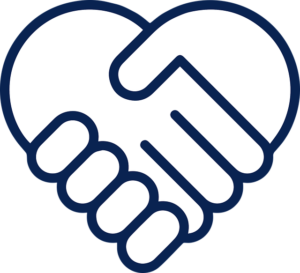February 4, 2024
Traceymay Kalvaitis
On the Cycle of Service
Isaiah 40: 28-29
Have you not known? Have you not heard? The LORD is the everlasting God, the Creator of the ends of the earth. He does not faint or grow weary; his understanding is unsearchable. He gives power to the faint and strengthens the powerless.
Mark 1:29-39
As soon as they left the synagogue, they entered the house of Simon and Andrew, with James and John. Now Simon’s mother-in-law was in bed with a fever, and they told him about her at once. He came and took her by the hand and lifted her up. Then the fever left her, and she began to serve them. That evening, at sunset, they brought to him all who were sick or possessed by demons. And the whole city was gathered around the door. And he cured many who were sick with various diseases and cast out many demons, and he would not permit the demons to speak, because they knew him. In the morning, while it was still very dark, he got up and went out to a deserted place, and there he prayed. And Simon and his companions hunted for him. When they found him, they said to him, “Everyone is searching for you.” He answered, “Let us go on to the neighboring towns, so that I may proclaim the message there also, for that is what I came out to do.” And he went throughout all Galilee, proclaiming the message in their synagogues and casting out demons.
*** Today’s sermon is titled, On the Cycle of Service.
This week we follow Jesus from the synagogue by the shores of the sea of Galilee to Simon’s house and there we learn that Simon’s mother-in-law is down with a fever. Her name is not revealed to us but in just two short sentences, a beautiful story is told. We read, Jesus “came and took her by the hand and lifted her up. Then the fever left her, and she began to serve them.” In less than two dozen words, this scene is described.
We can use our imaginations to fill in the details about how it would have been in close quarters, where multigenerations shared life under one roof. Simon’s mother-in-law would have been lying down in some out-of-the-way place in the small dwelling. She would have been unable to greet the guests as was the custom. Surely she has heard of Jesus. Her daughter is married to
Simon and it was Jesus who invited Simon to come and follow him. The scriptures tell us that
Simon and “his brother Andrew…immediately left their nets and followed him.”
I’m purely imagining here that Simon’s mother-in-law might have been a little less than pleased that some so-called prophet had lured her daughter’s husband away from his trade. What would this mean for the family’s security? And now, here she is, down with a fever when the prophet comes through the door. Jesus “came and took her by the hand and lifted her up. Then the fever left her, and she began to serve them.” Well, if she did not have a favorable opinion of him before, this surely changed her heart and her mind.
This next part, the part about her immediately beginning to serve them, used to really bother me when I was younger; I questioned why they were not serving her instead. After all, she was the elder and she had just been ill. Now that I am older, I understand. In the moment she was healed she was also restored, restored to a place where she could then serve the one who had helped her. It was her gratitude and her joy that naturally and effortlessly welled up and overflowed. In serving Jesus and his companions, she was completing the cycle of service; she was given back her health and her abilities and then she wanted to give of herself in whatever way she could. It is a beautiful cycle, the cycle of service.
I question whether or not we could say that it is human nature to give of ourselves, in service? If we look at the news headlines, it would be difficult to support this as being the case, what with wars between nations abroad, domestic gun violence here at home, and hate crimes in the U.S. tripling in the past few months. But in our everyday, face-to-face lives, a very different version of reality presents itself.
My youngest daughter and I were at Five Guys in Keene this past week, waiting on a to-go order. It was 6:30 on a Friday night and it was crowded in there. We were sitting on a ledge by the door and watching the scene. I said to my daughter, “Look at all these people together in this one place, peacefully co-existing.” Seconds after I said that, a woman headed for the door with her order dropped two straws, still in their paper wrappings, and three different people reached to
pick them up for her; they almost collided in their efforts to help her.
Researchers in Germany are finding that we humans might be born with an innate desire to help one another. The study included infants and toddlers from the ages of 6 months to three years of age. By the age of 12 months, infants were reliably able to point to an object that their parent was pretending to look for. Toddlers between the ages of 2 and 3, usually notorious for being possessive, were found to readily share with others who had previously shared with them.*
This last point is one that I find especially intriguing because it illustrates that the cycle of service can build momentum. When kindness is received, we are more likely to show kindness to others. I can feel the truth of this on a person-to-person level, but how might this inform us as we seek positive social changes on a broader scale?
I recall an idea my Father had back in 2008 when the automobile industry received 15 million in bail-outs from the Federal government. He thought that the money could have been better used in vouchers for American-made automobiles. I did the math. Every adult over 18 in the country could have received 10,000 towards the purchase of an American-made car. The automobile companies would have had ample business, they would have gathered loyal customers in the
long run, and just imagine the sense of goodwill established by such an action. Imagine the gratitude, imagine the growing sense of optimism that would come from the government not just supporting big business, but improving the lives of everyone in the process.
Our Teacher, Jesus of Nazareth, affected similar changes through healing those who were islolated from society because of their physical and mental illnesses. In his day, there were no publicly-funded programs for education and care of the blind, the lame, and those suffering from leprosy or other life-long diseases of the body and mind. People who were alter-abled or coping with illnesses were very much dependent on the mercy of their community for care. Those whom Jesus healed were not just healed in body; they were healed in spirit. They could then
find their place in a larger cycle of service, eager to give back to others, and ready to pass on the blessings they had received. The prophet Isaiah would approve wholeheartedly, I imagine. In our reading this morning, we heard the following words, “God gives power to the faint and strengthens the powerless.”
We are in need of healing on many levels in our society and the story of Jesus’s healing of
Simon’s mother-in-law inspires me to think about a much larger picture of what happens when one person is moved from a place of inability to a place of ability. Healing comes in many forms and healing is not necessarily the same thing as curing, either. People speak of being healed when their illness or affliction or life circumstances no longer have power over them. I know people who have been healed even though they have not been cured and I am guessing that you know of people, too, who have found ways to live in fullness even as they are challenged, sometimes severely. It seems to me that living in fullness is made possible by placing oneself somewhere in that cycle of service. Sometimes we are the healer, offering words of encouragement, words of forgiveness, or acts of service to another. Sometimes we are the receivers. Sometimes we are the ones in need of healing, encouragement, forgiveness and assistance. Both ways, in giving and in receiving, we can experience deep healing and restoration.
In closing, I lift up the power of one in the cycle of service. Simon’s mother-in-law was one woman, healed of her illness, can serve her community once again. My father is one man with one good idea that could change a nation. Jesus, the Holy One of God, was one teacher who started a spiritual revolution that continues to play out to this day. Friends, may we resist apathy, hopelessness and pessimism, and remember we were born with an innate sense to be of service
to one another. May we love with all our hearts, turn our minds to the source of goodness in God, and take our place in the cycle of service, giving and receiving without judgement, and full of grace. So be it. Amen.
*https://www.nytimes.com/2009/12/01/science/01human.html
**https://www.pbs.org/independentlens/blog/the-science-of-kindness-its-not-easy-being-nic e/
I did not use this second article, but it is very interesting as it explains how it is the youngest part of our brains, the pre-frontal cortex, that allows us to imagine, empathize, and extend ourselves in service to others.
Benediction
I leave you with the following words from Ephesians chapter 5:
“Walk as children of light, for the fruit of the light is in all goodness and justice and truth.”


